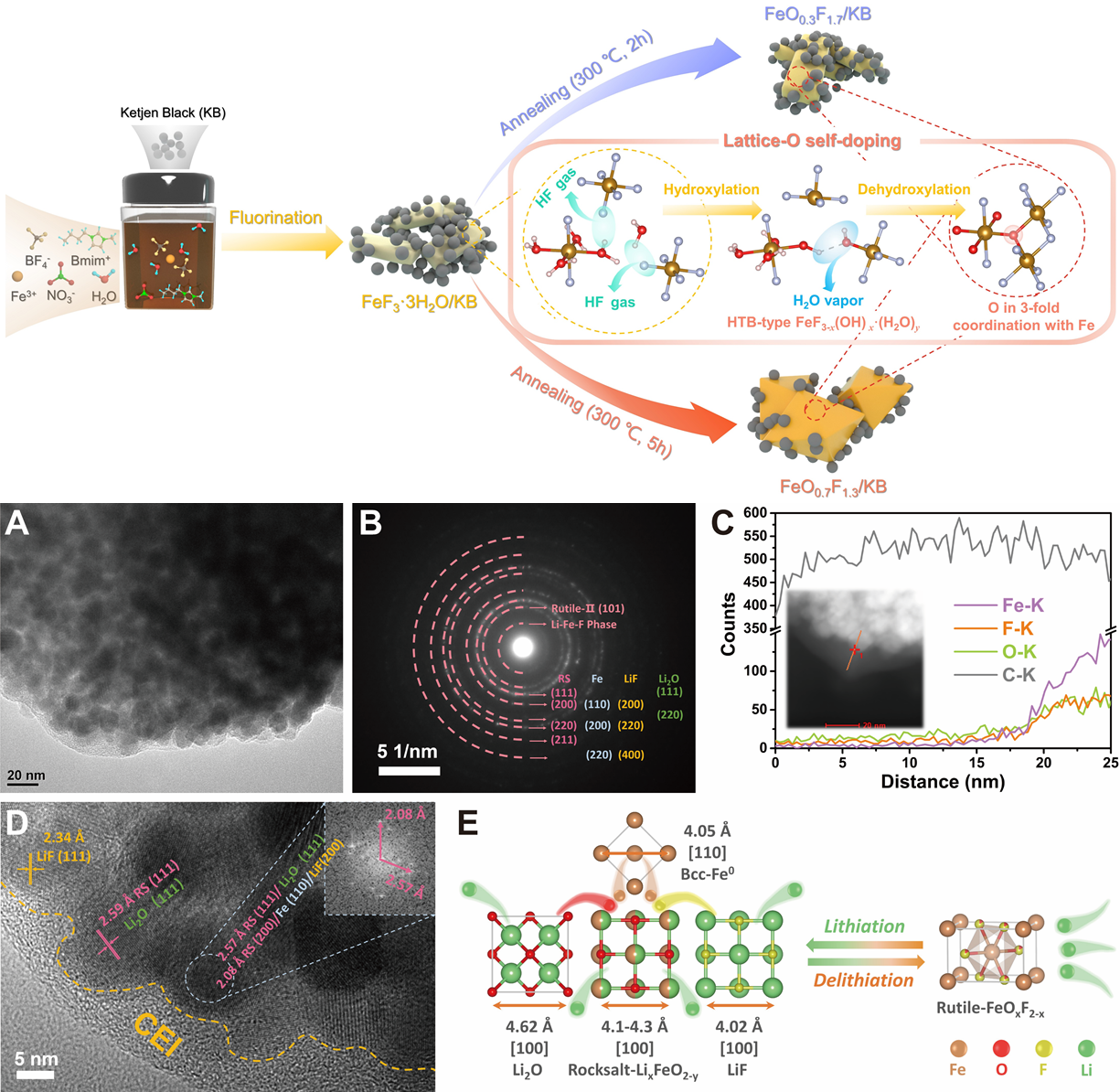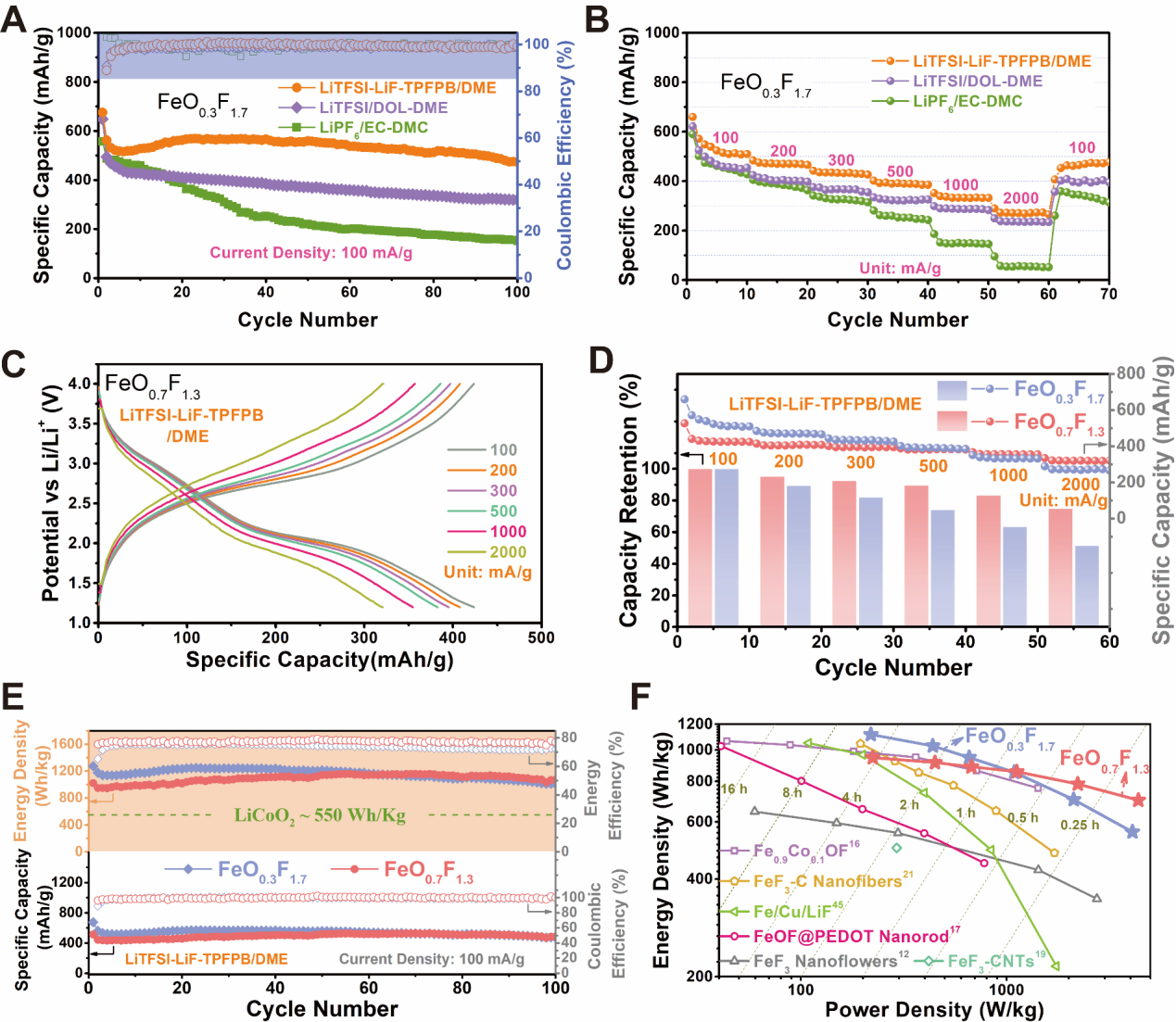Scientists Develop High-Energy Lithium-Fluoride Batteries Based on a Novel Solid-Liquid Fluorine Conversion Mechanism
The Lithium metal batteries based on Li metal anode coupled with conversion-type cathode have emerged to meet the demands of next-generation energy storage technology for large-scale application of powerful electromobility systems such as electric vehicles and all-electric aircraft.
Among conversion-type cathodes, iron trifluoride (FeF3) is considered as a promising candidate, which can offer an extremely high energy density of 1947 Wh/kg (based on a theoretical capacity of 712 mAh/g with a thermodynamic potential of ~2.73 V) via three electron transfer. Different from molecule cathodes (e.g., S8 and O2), FeF3 can effectively mitigate the loss of cathode active species and the occurrence of anode side reactions caused by the difficulty of reaction-zone confinement.
However, the intrinsic solid-solid conversion of fluoride is sluggish during repeated splitting and rebonding of metal-fluorine moieties. In particular for Li-driven fluoride conversion, heterogeneous precipitation and coverage of insulating lithium fluoride (LiF) on the whole electrode surface would impede the internal chemical reaction between active fluoride and lithium, consequently causing large voltage hysteresis and low available capacity.
Recently, the research team led by Prof. LI Chilin from Shanghai Institute of Ceramics, Chinese Academy of Sciences has made progress in conversion-type lithium-fluoride batteries.
In view of the sluggish kinetics and poor reversibility of lithium-fluorine conversion reactions, they proposed a novel solid-liquid fluorine conversion mechanism enabled by a fluoride anion receptor of tris(pentafluorophenyl)borane (TPFPB). TPFPB promotes the dissociation of inert lithium fluoride and provides a facile “fluorine transport channel” at multiphase interfaces via the formation of solvated F-intermediate therein. The construction of solid-liquid channel could bypass tough solid-solid conversion and upgrade the fluoride conversion kinetics, and then achieve the sustaining cycling of conversion-type lithium-fluoride batteries with high capacity and energy efficiency.
The related result is published in Science Advances (2021, 7, eabj1491) entitled "Construction of solid-liquid fluorine transport channel to enable highly reversible conversion cathodes".
TPFPB has an electron deficient boron center, which exhibits a strong attraction to electron-rich fluorine. TPFPB with F-binding affinity favorably promotes LiF splitting, and enables the F-state transformation from the solid LiF lattice to the solvated [TPFPB-F]-intermediate. For the Li-driven Fe-F conversion system, the dissolved F-tends to react with the oxidized Fe species in the reconversion process. The construction of solid-liquid fluorine channel not only improves the original rough solid-solid contact, but also kinetically promotes the F-sublattice conversion from Li-F to Fe-F structure, as indicated by the evidently reduced reaction energy barrier of LiF-Fe system.
Additionally, the research team develops a thermal-induced self–oxygen penetration method for the structure optimization of fluoride cathode. Two kinds of iron (oxy)fluoride composites (denoted as FeO0.3F1.7 and FeO0.7F1.3) were synthesized via sequential hydroxylation/dehydroxylation of hydrated iron fluoride under annealing treatment. The O doping in fluoride regulates the phase evolution pathway and introduces a stable second-generation parent phase of rock salt in the confined voltage region for conversion reaction.
Benefiting from the construction of facile round-trip F/Li-transport pathways and the optimization of fluoride structure, FeO0.3F1.7 and FeO0.7F1.3 cathodes enable the sustaining conversion reaction with energy efficiency approaching 80%, high capacity retention of 472 and 484 mAh/g after 100 cycles, and superior rate capability with reversible capacities of 271 and 320 mAh/g at 2 A/g. Their energy densities are achieved at 1100 Wh/kg for FeO0.3F1.7 and 700 Wh/kg for FeO0.7F1.3 under the power densities of 220 and 4300 W/kg, respectively. The key finding of solid-liquid fluorine channel provides an effective strategy to develop fluorine-conversion battery systems with high energy density.
This work was supported by the National Key R&D Program of China, National Natural Science Foundation of China, and Shanghai Science and Technology Committee.

Characterization of solid-liquid F-transport channel enabled by anion receptor of TPFPB

Schematic illustration of the preparation process of iron oxyfluorides via thermal-induced self–oxygen penetration method and the phase conversion mechanism of iron oxyfluorides

The effect of solid-liquid F-transport channel on promoting the electrochemical performance of FeO0.3F1.7 and FeO0.7F1.3 cathodes
Reference:
https://www.science.org/doi/10.1126/sciadv.abj1491
Contact:
Prof. LI Chilin
Shanghai Institute of Ceramics
Email: chilinli@mail.sic.ac.cn



